Divisional gun ZIS-3: the biography of the record holder
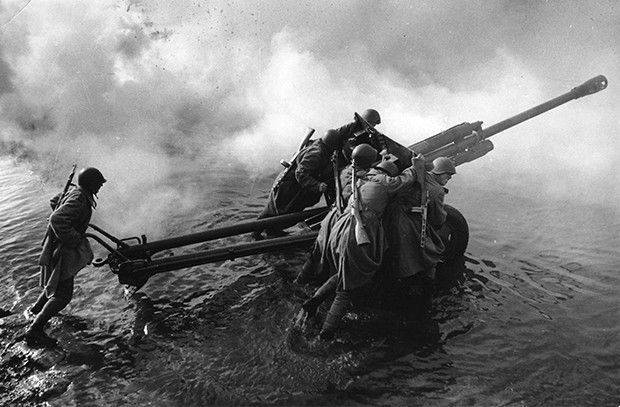
As a designer, Vasily Grabin managed to create a weapon that became the most massive in stories world artillery
The Soviet soldiers, first of all the artillery of the divisional and anti-tank artillery regiments, for simplicity, obedience and reliability called her affectionately - “Zosya”. In other parts, for the rate of fire and high combat characteristics, she was known by the popular version of the abbreviation in the name - “Volley of Stalin”. It was often called her simply “Grabin’s cannon” - and no one needed to explain what particular instrument was in question. And the soldiers of the Wehrmacht, among whom it was difficult to find one who would not know this gun by the sound of a shot and a gap and would not be afraid of its rate of fire, this weapon was called “Ratsch-Bumm” - “Ratchet”.
In official documents, this weapon was called "76-mm divisional gun model 1942 of the year." It was this gun that was the largest in the Red Army, and, perhaps, the only one that was equally used in divisional and anti-tank artillery. And it was also the first artillery piece in the world, the production of which was put on the conveyor. Due to this, it became the most massive cannon in the history of world artillery. In total, 48 016 guns were launched in the USSR as a divisional gun and 18 601 as a modification of the SU-76 and SU-76 self-propelled guns. Never again, neither before nor after, have there been so many units of the same gun in the world.
This gun - ZIS-3, got its name from the place of its birth and production, to the plant named after Stalin (aka plant No. 92, aka "New Sormovo") in Gorky. She became one of the most recognizable symbols of the Great Patriotic War. Her silhouette is so famous that any Russian who barely saw him will immediately understand which era he is talking about. This gun more often than any other Soviet artillery guns is found as a monument to the heroes of the Great Patriotic War. But this could not have happened if it were not for the stubbornness and belief in the rightness of the creator of ZIS-3 artillery designer Vasily Grabin.
“Your guns are not needed!”
ZIS-3 rightly called the legendary - including because the history of its creation is fanned by many legends. One of them states that the first copy of the ZIS-3 went out of the gate of the plant number 92 the day the war began, 22 June 1941 of the year. But, unfortunately, it was not possible to find documentary evidence of this. And it’s quite surprising that Vasily Grabin himself does not say a word about such a symbolic coincidence in the fate of his most famous weapon. In the book of memories "Weapon victories, ”he writes that on the day the war began, he was in Moscow, where he learned from Molotov’s radio address the tragic news. And not a word that something significant happened on the same day in the fate of the ZIS-3 cannon. But the exit of the first gun outside the factory gates is not an event that could have occurred secretly from the chief designer.
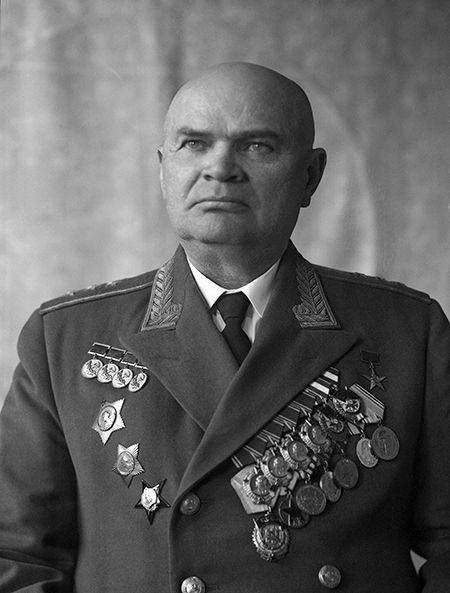
But it is absolutely certain that exactly one month after the German attack, 22 July 1941, the ZIS-3 division gun was presented in the courtyard of the People's Commissariat of Defense to the Deputy Commissar, the former head of the Main Artillery Directorate, Marshal Grigori Kulik. And it was he who almost put an end to the fate of a future legend.
This is what Vasily Grabin himself recalled about this show: “Considering that putting each new gun on gross production and re-equipping the Red Army is a difficult, time-consuming and expensive process, I stressed that everything is simple and fast with regard to ZIS-3, because it is a 76-millimeter barrel superimposed on the gun carriage of the 57-millimeter anti-tank gun ZIS-2, which we have on gross production. Therefore, putting on the production of ZIS-3 will not only not burden the plant, but, on the contrary, will facilitate the fact that instead of two guns F-22 USV and ZIS-2 will go into production alone, but with two different tubes of the barrel. In addition, the ZIS-3 will cost the plant three times cheaper than the F-22 SPM. All this taken together will allow the plant to immediately increase the production of divisional guns, which will be not only easier to manufacture, but easier to maintain and more reliable. In concluding, I suggested adopting the ZIS-3 divisional gun instead of the FV X-NUMX divisional gun.
Marshal Kulik wanted to see the ZIS-3 in action. Gorshkov gave the command: "Calculation, to the gun!". People quickly took their places. Various new teams followed. They were performed just as clearly and quickly. Kulik ordered the gun to be rolled out to an open position and the conditional “firing at tanks". In a matter of minutes, the cannon was ready for battle. Kulik indicated the appearance of tanks from different directions. Gorshkov’s teams sounded (Ivan Gorshkov - one of the leading designers of the Grabinsky Design Bureau in Gorky. - RP): “Tanks on the left ... front”, “Tanks on the right ... back”. The gun crew worked as a well-functioning mechanism. I thought: “Gorshkov’s work paid off.”
Marshal praised the calculation for clarity and speed. Gorshkov gave the command: “Hang up!”, ZIS-3 was installed at the initial position. After that, many generals and officers approached the gun, took over the flywheels of the guidance mechanisms and worked with them, turning the barrel in different directions in azimuth and in a vertical plane. ”
All the more surprising, for the designer, Marshal Kulik’s reaction to the demonstration results turned out to be more impossible. Although it could probably have been predicted, bearing in mind that even in March of the same year, the very same Kulik, when Grabin carefully probed the ground over the possibility of starting production of ZIS-3, strongly stated that the Red Army did not need new or additional divisional the guns. But the beginning of the war, apparently, wiped out the March conversation. And here in the marshal's office the next scene takes place, which Vasily Grabin literally cites in his book of memoirs “The Weapon of Victory”:
“Kulik rose. He smiled slightly, looked around the audience and stopped him at me. I appreciated this as a positive sign. Kulik was silent for a while, preparing to state his decision, and expressed:
“You want a plant of an easy life, while blood is shed on the front.” Your guns are not needed.
He fell silent. It seemed to me that I mishear or he made a reservation. I only managed to pronounce:
- How?
- And so, not needed! Go to the factory and give more of those guns that are in production.
Marshal continued to stand with the same victorious look.
I got up from the table and went to the exit. No one stopped me, no one told me anything. ”
Six years and one night
Probably, everything would be much simpler if the ZIS-3 were a tool developed by the Grubin KB on the instructions of the military. But this gun was created as an initiative from the bottom. And the main reason for its appearance, as far as can be judged, was Vasily Grabin’s categorical opinion that the Red Army lacks quality divisional guns, convenient and easy to manufacture and use. Opinion, which was fully confirmed in the first months of the war.
Like all ingenious, ZIS-3 was born, one might say, simply. “Some artist (this phrase is attributed to the English painter William Turner. - RP) to the question how long he painted the picture, replied:“ All my life and another two hours, ”wrote Vasily Grabin later. “Similarly, we could say that the ZIS-3 cannon had been working for six years (since the establishment of our design bureau) and one more night.”
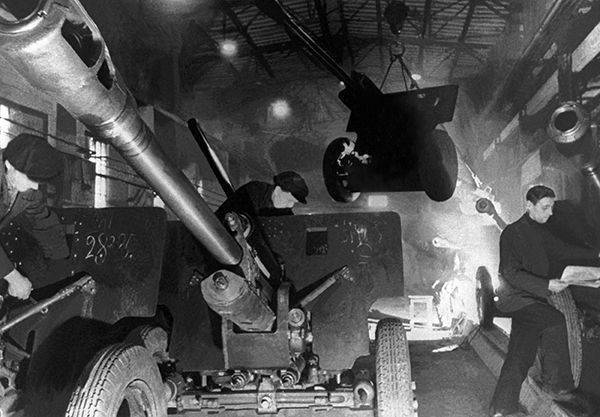
The night, about which Grabin writes, was the night of the first tests of the new gun at the factory site. Figuratively speaking, it was assembled, as a designer, from parts of other guns already produced by the Gorky plant. Flounder - from 57-millimeter anti-tank gun ZIS-2, adopted in March 1941. The barrel is from the divisional gun F-22 SPM that is in service: the semi-finished product was modified for new tasks. Only the muzzle brake was brand new, which was developed from scratch in a few days by the designer of the design bureau Ivan Griban. During the evening, all these parts were assembled together, the gun was shot out at the test site - and the factory workers unanimously decided that the new tool that the factory ZIS-3 index had been!
After this fateful decision in the design bureau, they began to refine the novelty: it was necessary to turn a set of dissimilar parts into a single organism, and then develop documentation for the production of the instrument. This process stretched until the summer of 1941. And then the war said its word in favor of the release of a new gun.
Knocking on Stalin
Until the end of 1941, the Red Army lost almost 36,5 thousand field guns in fights with the Wehrmacht, of which the sixth part - 6463 units - made 76-mm divisional guns of all models. "More guns, more guns!" - Demanded the Commissariat of Defense, the General Staff and the Kremlin. The situation was becoming disastrous. On the one hand, the plant named after Stalin, the same number 92, could not provide a sharp increase in the production of guns already in service - it was very labor-intensive and difficult. On the other hand, the ZIS-3 was technologically simple and suitable for mass production, but the military leadership did not even want to hear about the launch of a new gun instead of the ones already produced.
It requires a small digression devoted to the personality of Vasily Grabin himself. The son of an artilleryman of the Russian Imperial Army, a graduate-excellent student of the Military Technical Academy of the Red Army in Leningrad, at the end of 1933, he headed the design bureau, created on his initiative on the basis of the Gorky plant No. 92 "New Sormovo". It was this bureau in the pre-war years that developed several unique tools — both field and tank ones — that were adopted. Among them was the anti-tank gun ZIS-2, tank guns F-34, standing on the T-34-76, C-50, which was armed with tanks T-34-85, and many other systems.
The word “multitude” is key here: the grab community of Design Bureau, like no other, developed new tools in terms ten times smaller than it was then accepted: three months instead of thirty! The reason for everything was the principle of unification and reduction of the number of parts and assemblies of guns - the one that most vividly embodied in the legendary ZIS-3. Vasiliy Grabin himself formulated this approach in the following way: “Our thesis was this: the gun, including each of its units and mechanisms, should have a low link, should consist of the smallest number of parts, but not due to their complication, but due to the most rational constructive scheme , providing simplicity and the lowest labor intensity during machining and assembly. The design of the parts should be so simple that they can be processed with the help of simple tools and simple tools. And one more condition: the mechanisms and units must be assembled individually and consist of nodes, in turn, each assembled independently. The main factor in all the work was the economic requirements with the unconditional preservation of service and operational qualities of the gun. "
The unique capabilities of the Grabinsky Design Bureau, coupled with Grabin’s stubbornness (his rivals, whom he had enough, called it stubbornness) in asserting their position, allowed the designer to quickly gain confidence in the highest echelons of power. Grabin himself recalled that Stalin had addressed him directly several times, attracting him as chief adviser on complex artillery issues. Detractors of Grabin, however, argued that he simply knew how to submit the necessary remarks to the “father of nations” in time - that’s the whole reason for Stalin’s love.
One way or another, but as far as is known, he used special relations with the all-powerful General Secretary Grabin not to satisfy his own ambitions, but to give the army those guns that he was convinced she really needed. And in the fate of the legendary ZIS-3 is persistence, or stubbornness, Grabin and his relationship with Stalin played a decisive role.
"We will take your gun"
4 January 1942, at a meeting of the State Committee for Defense Grabin, was waiting for a real defeat. All his arguments in favor of replacing the pre-war 76-millimeter divisional guns with the new ZIS-3 by the general secretary were abruptly and unconditionally. It got to the point that, as the designer recalled, Stalin grabbed a chair behind the back and slammed his legs on the floor: “You have a design itch, you all want to change and change! Work as you did before! ” And the next day, the chairman of the State Defense Committee called Grabin with the words: “You are right ... What you did is not immediately understood and appreciated. Moreover, will they understand you soon? After all, what you have done is a revolution in technology. Central Committee, T-bills and I highly appreciate your achievements. Quietly finish the job started. ” And then the designer who had gained arrogance once again told Stalin about the new gun and asked for permission to show him the gun. Grabin recalled, reluctantly, but he agreed.
The show took place the next day in the Kremlin. Vasily Grabin himself best of all spoke about how he was happening in his book “The Weapon of Victory”:
“Stalin, Molotov, Voroshilov and other members of the State Defense Committee came to inspect, accompanied by marshals, generals, responsible officers of the People's Commissariat of Defense and the People's Commissariat of Weapons. All were dressed warmly, except for Stalin. He went out light - in his cap, overcoats and boots. And the day was extremely frosty. It worried me: in the bitter cold, in such light clothes it is impossible to carefully read the new gun.
They reported about the gun everything except me. I just made sure that someone did not mess up. Time passed, and there was no end to the explanations. But Stalin departed from the rest and stopped at the cannon shield. I approached him, but did not have time to utter a word, as he asked Voronov (Colonel General Nikolai Voronov, head of the Red Army artillery. - RP) to work on guidance mechanisms. Voronov took the flywheel handles and began to diligently rotate them. The top of his papakhi was visible above the shield. “Yes, the shield is not for the growth of Voronov,” I thought. At this time, Stalin raised his hand with outstretched fingers, except for the big and little finger, which were pressed to the palm, and turned to me:
- Comrade Grabin, the life of the fighters must be protected. Increase the height of the shield.
He did not have time to say how much to increase, as a “good adviser” was immediately found:
- At forty centimeters.
- No, just with three fingers, Grabin sees it well himself.
Having finished the inspection, which lasted several hours - during this time, everyone became acquainted not only with the mechanisms, but even with some details - Stalin said:
- This gun is a masterpiece in the design of artillery systems. Why did you not give such a beautiful gun before?
“We have not yet been prepared to deal with constructive issues like this,” I replied.
- Yes, that's right ... We will accept your gun, let the military test it.
Many of those present knew well that there were at least a thousand ZIS-3 cannons on the front and that the army appreciated them highly, but no one had said that. I kept silence too.
Soviet triumph
After such a triumph and an unequivocally expressed will of the leader, the tests turned into a simple formality. A month later, 12 February, ZIS-3 adopted. Formally, it was from that day that her front-line service began. But it was not by chance that Grabin recalled “a thousand ZIS-3 cannons”, which had already fought by then. These guns were collected, one might say, by smuggling: that few people in the assembly were not serial samples, but something new, at factory No. 92. The only "traitorous" detail - the muzzle brake, which other manufactured guns did not have - was made in the experimental workshop, which did not surprise anyone. And on ready-made barrels, which differed almost nothing from the barrels to other guns and lying on the carriages from the ZIS-2, they were placed late in the evening, with a minimum number of witnesses.
But when the gun was officially put into service, it was necessary to fulfill the promise made by the management of the design bureau and the plant: to increase the production of guns 18 times! And, oddly enough to hear it today, the designer and director of the plant kept their word. Already in 1942, the release of guns increased 15 times and continued to grow. This is best judged by the dry numbers of statistics. In 1942, the Stalin plant produced 10 139 cannons ZIS-3, in 1943-m - 12 269, in 1944-m - 13 215, and in the victorious 1945-m - 6005 guns.
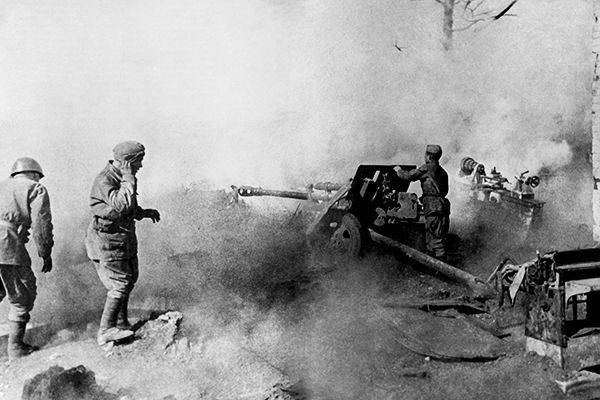
The fact that such a production miracle turned out to be possible can be judged by two episodes. Each of them very vividly demonstrates the capabilities and enthusiasm of the employees of the design bureau and the plant.
As Grabin recalled, one of the most difficult operations in the production of the ZIS-3 was cutting the window under the wedge of the shutter - there was a more high-speed wedge lock on the gun. This was done on slotting machines by workers of the highest qualification, as a rule, with golden-haired masters golden hands, which already had no marriage fixed. But there were not enough machines and craftsmen to increase the output of the gun. And then it was decided to replace the slotting with a broach, and the broaching machines at the factory developed themselves and as soon as possible. “For the drawing machine, a third-level worker began to prepare, in the recent past, a housewife,” Vasiliy Grabin later recalled. - The preparation was purely theoretical, because the machine itself was not yet operational. The old slotters, while the machine was debugged and mastered, looked at him ironically and chuckled secretly. But they did not have long to laugh. As soon as the first fit breeders were received, they were alarmed in earnest. And when the former housewife began to give out one breech after another, and without marriage, it finally shocked them. They doubled the production, but still could not keep up with the broach. The old dabblers looked with admiration at the broach, despite the fact that she had “eaten” them. ”
And the second episode concerns the brand distinction of the ZIS-3 - the characteristic muzzle brake. Traditionally, this detail, experiencing enormous loads at the moment of the shot, was done like this: the workpiece was forged, and then highly skilled workers processed it during 30 (!) Hours. But in the autumn of 1942 of the year, the newly appointed deputy director of the plant number 92 for metallurgical production, Professor Mikhail Struseba, suggested casting the muzzle brake blank using a metal mold, a drop-down, reusable shape. The processing of such a casting took only 30 minutes - 60 times less time! In Germany, this method was never mastered by the end of the war, continuing to forge the muzzle brakes in the old manner.
Forever in the ranks
In the Russian military museums there are more than a dozen copies of the legendary ZIS-3 cannon. On account of some of them - 6 – 9 thousands of kilometers traveled along the roads of Russia, Ukraine, Belarus and Europe, dozens of destroyed tanks and dots, hundreds of Wehrmacht soldiers and officers. And this is absolutely not surprising, given the reliability and simplicity of these guns.
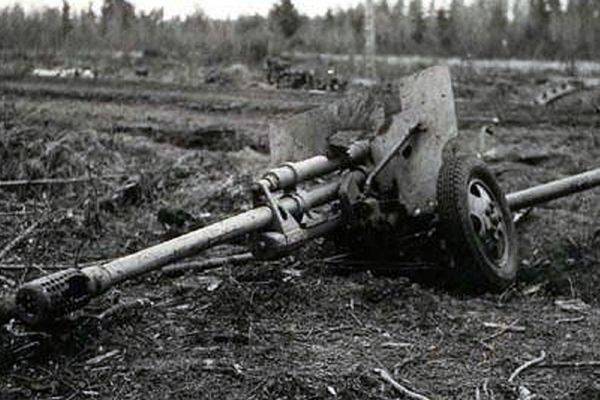
And more about the role of the 76-mm ZIS-3 divisional gun in the Great Patriotic War. In 1943, this gun became the main one both in divisional artillery and in anti-tank artillery fighter regiments, where it was a regular gun. Suffice it to say that in 1942 and 1943 the 8143 and 8993 guns were delivered to the anti-tank artillery, and the 2005 and 4931 guns to the divisional artillery respectively, and the ratio becomes approximately equal only in 1944.
The post-war fate of the ZIS-3 was surprisingly long. Its release was stopped immediately after the Victory, and a year later the X-NUMX-mm divisional gun D-85, which came to replace it, was adopted. But, despite the appearance of a new cannon, the Zosya, which has proved itself on the fronts of the Great Patriotic War, has been in service for more than a decade, but not in their homeland, but beyond its borders. A large part of these guns was handed over to the armies of the “fraternal socialist countries”, which used them themselves (for example, in Yugoslavia, this weapon fought until the end of the Balkan wars of the new time) and sold to third countries that needed cheap but reliable weapons. So even today in the videotape of the fighting somewhere in Asia or Africa, you can no-no, and notice the characteristic silhouette of the ZIS-44. But for Russia this gun was and will remain one of the main symbols of the Victory. Victory, inherited by the price of unprecedented exertion of strength and courage both at the front and in the rear, where the weapons of the victors were forged.
Information